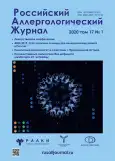Evaluation of the efficacy and safety of 10% intravenous immunoglobulin Privigen in real clinical practice
- Authors: Khludova LG1, Manto IA1, Latysheva E.A1, Latysheva TV1, Khaitov MR2
-
Affiliations:
- NRC Institute of immunology FMBA of Russia
- ФГБУ «ГНЦ Институт иммунологии» ФМБА России
- Issue: Vol 16, No 4 (2019)
- Pages: 48-56
- Section: Articles
- URL: https://journals.rcsi.science/raj/article/view/121474
- DOI: https://doi.org/10.36691/RAJ.2020.16.4.006
- ID: 121474
Cite item
Full Text
Abstract
Full Text
##article.viewOnOriginalSite##About the authors
L G Khludova
NRC Institute of immunology FMBA of Russiaмладший научный сотрудник отделения иммунологии взрослых Moscow, 115522, Russian Federation
I A Manto
NRC Institute of immunology FMBA of Russiaмладший научный сотрудник отделения иммунологии взрослых Moscow, 115522, Russian Federation
Elena A Latysheva
NRC Institute of immunology FMBA of Russia
Email: Ealat@mail.ru
доцент, доктор медицинских наук, старший научный сотрудник отделения Moscow, 115522, Russian Federation
T V Latysheva
NRC Institute of immunology FMBA of Russiaпрофессор, доктор медицинских наук, Заслуженный врач РФ, зав. отделением иммунологии взрослых Moscow, 115522, Russian Federation
M R Khaitov
ФГБУ «ГНЦ Институт иммунологии» ФМБА Россиичлен-корреспондент РАМН, директор Moscow, 115522, Russian Federation
References
- Picard C, Al-Herz W, Bousfiha A, Casanova JL, Chatila T, Conley ME. Primary immunodeficiency diseases: an update on the classification from the International Union of Immunological Societies Expert Committee for Primary Immunodeficiency 2015. J Clin Immunol. 2015;35(8):696-726. doi: 10.1007/s10875-015-0201-1.
- Al-Herz W, Bousfiha A, Casanova JL, Chatila T, Conley ME, Cunningham-Rundles C. Primary Immunodeficiency Diseases: An Update on the Classification from the International Union of Immunological Societies Expert Committee for Primary Immunodeficiency. Front Immunol. 2014;5. doi: 10.3389/fimmu.2014.00162. Available from: https://www. frontiersin.org/articles/10.3389/fimmu.2014.00162/full.
- Schäffer A, Salzer U, Hammarström L, Grimbacher B. Deconstructing common variable immunodeficiency by genetic analysis. Curr Opin Genet Dev. 2007;17(3):201-212. doi: 10.1016/j.gde.2007.04.002.
- Di Renzo M, Pasqui A, Auteri A. Common variable immunodeficiency: a review. Clin Exp Med. 2004;3(4):211-217. doi: 10.1007/s10238-004-0027-2.
- Picard C. Primary Immunodeficiency Diseases: an Update on the Classification from the International Union of Immunological Societies Expert Committee for Primary Immunodeficiency J Clin Immunol. 2015; 35(8):696-726.
- Мухина АА, Кузьменко НБ, Родина ЮА, Кондратенко ИВ, Бологов АА, Латышева ТВ. Характеристика пациентов с первичными иммунодефицитными состояниями в Российской Федерации: от рождения до старости. Педиатрия, 2019;98(2):24-31. DOI: 10/241100/0031-403X-2019-98-3-24-31 [Characteristics of patients with primary immunodeficiency states in the Russian Federation: from birth to old age. Mukhina AA, Kuzmenko NB, Rodina YA, Kondratenko IV, Bologov AA, Latysheva TV. Pediatrics. 2019;98(2):24-31 (In Russ.)].
- Roifman C, Levison H, Gelfand E. High-dose versus low-dose intravenous immunoglobulin in hypogammaglobulinaemia and chronic lung disease. The Lancet. 1987;329(8541):1075-1077. doi: 10.1016/s0140-6736(87)90494-6.
- Eijkhout H, van der Meer J, Kallenberg C, Weening RS, van Dissel JT, Sanders LA. The Effect of Two Different Dosages of Intravenous Immunoglobulin on the Incidence of Recurrent Infections in Patients with Primary Hypogammaglobulinemia. Ann Intern Med. 2001;135(3):165. doi: 10.7326/0003-4819135-3-200108070-00008.
- Roifman C, Schroeder H, Berger M, Sorensen R, Ballow M, Backley RH. Comparison of the efficacy of IGIV-C, 10% (caprylate/chromatography) and IGIV-SD, 10% as replacement therapy in primary immune deficiency. Int Immunopharmacol. 2003;3(9):1325-1333. DOI: 10.1016/ s1567-5769(03)00134-6
- Chapel H, Cunningham-Rundles C. Update in understanding common variable immunodeficiency disorders (CVIDs) and the management of patients with these conditions. Br J Haematol. 2009;145(6):709-727. doi: 10.1111/j.1365-2141.2009.07669.x.
- Cramer M, Frei R, Sebald A, Mazzoletti P, Maeder W Stability over 36 months of a new liquid 10% polyclonal immunoglobulin product (IgPro10, Privigen) stabilized with L-proline. Vox Sang. 2009;96(3):219-225. doi: 10.1111/j.1423-0410.2008.01143.x.
- Tankersley D, Preston M, Finlayson J. Immunoglobulin G dimer: An idiotype-anti-idiotype complex. Mol Immunol. 1988;25(1):41-48. doi: 10.1016/0161-5890(88)90088-0.
- Roux KH, Tankersley DL. A view of the human idiotypic repertoire. Electron microscopic and immunologic analyses of spontaneous idiotype-antiidiotype dimers in pooled human IgG. J Immunol. 1990;144(4):1387-1395.
- Spycher MO, Bolli R, Hodler G, Gennari K, Hubsch A, Spath P, Schnorf J. Well-tolerated liquid intravenous immunoglobulin G preparations (IVIGs) have a low immunoglobulin G dimer (IgG-dimer) content. J Autoimmun. 1999;96(Suppl. 1):96.
- Bolli R, Woodtli K, Bartschi M, Hofferer L, Lerch P. L-Proline reduces IgG dimer content and enhances the stability of intravenous immunoglobulin (IVIG) solutions. Biologicals. 2010;38(1):150-157. doi: 10.1016/j.biologicals.2009.09.002.
- Sleasman JW, Duff CM, Dunaway T, Rojavin MA, Stein MR. Tolerability of a new 10% liquid immunoglobulin for intravenous use, Privigen, at different infusion rates. J Clin Immunol. 2010;30(3):442-448. doi: 10.1007/s10875-010-9373-x.
- Stein MR, Nelson RP, Church JA, Wasserman RL, Borte M, Vermylen C. IgPro10 in PID study group. Safety and efficacy of Privigen, a novel 10% liquid immunoglobulin preparation for intravenous use, in patients with primary immunodeficiencies. J Clin Immunol. 2009;29(1):137-144. DOI: 10.1007/ s10875-008-9231-2.
- Church JA, Borte M, Taki H, Nelson RP, Sleasman JW, Knutsen AP. Efficacy and safety of Privigen in children and adolescents with primary immunodeficiency. Ped Asthma Allergy Immunol. 2009;22(2):53-61. doi: 10.1089/pai.2009.0005.
- Robak T, Salama A, Kovaleva L, Vyhovska Y, Davies SV, Mazzucconi MG. Efficacy and safety of Privigen, a novel liquid intravenous immunoglobulin, in adolescent and adult patients with chronic immune thrombocytopenic purpura. Hematology. 2009;14(4):227-236. doi: 10.1179/102453309x439773.
- Leger JM, De Bleecker J, Sommer C, Robberecht W, Saarela M, Kamienowski J. Efficacy and safety of Privigen in patients with chronic inflammatory demyelinating polyneuropathy: results of a prospective, single-arm, open-label Phase III study (the PRIMA study) Journal of the Peripheral Nervous System. 2013;18(2):130-140. doi: 10.1111/jns5.12017.
- O’Donnell JL, Roberts-Thomson pJ, Ahem MJ, Bradley J. Alteration in circulating neutrophil CR3 density associated with immunoglobulin infusion. Aust NZ J Med. 1988;18:95-100.
- Orbach H, Katz U, Sherer Y, Shoenfeld Y Intravenous immunoglobulin: adverse effects and safe administration. Clin Rev Allergy Immunol. 2005;29:173-184. DOI: 10.1385/ criai:29:3:173.
- Woodruff RK, Grigg AP, Firkin FC, Smith IL. Fatal thrombotic events during treatment of autoimmune thrombocytopenia with intravenous immunoglobulin in elderly patients. Lancet. 1986;2(8500):217-218. doi: 10.1016/s0140-6736(86)92511-0.
- Sztajzel R, Le Floch-Rohr J, Eggimann P. High-dose intravenous immunoglobulin treatment and cerebral vasospasm: a possible mechanism ofischemic encephalopathy? Eur Neurol. 1999;41:153-158. doi: 10.1159/000008040.
Supplementary files






